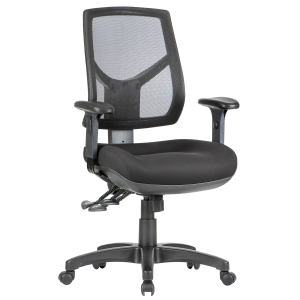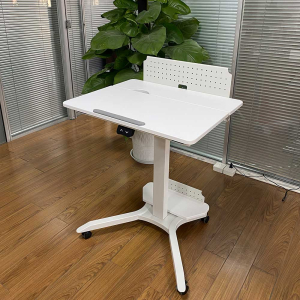Meeting room setups play a subtle but vital role in productivity and collaboration. People need to be comfortable and be able to communicate easily. Room layout and tools like whiteboards and presentation screens are essential, but you should consider meeting room chairs. A lack of support and comfort could leave attendees waiting for the end of a long meeting instead of focusing on the task at hand.
Why meeting room variety matters
There is no single “best” meeting room variety. Different setups work for various types of meetings. You always need to match the room design with the meeting variety. If they are comfortable and have the correct layout, equipment and office chairs, employees can work without distraction and without wasting time to make adjustments.
Here is a look at 10 meeting room varieties and the best meeting room chairs for each.
1. Conference rooms
Conference rooms have a large area with a table and meeting chairs to accommodate many attendees. These rooms often host formal meetings. The layout allows everyone to see a presentation on a board or screen and participate in discussions.
Furniture can include executive office chairs with a high backrest, tilt and swivel functions, and high-quality fabrics, like leather. Another option is a boardroom chair, which offers ergonomic design and armrests. Both conference room chairs are ideal for extra comfort during long meetings that often occur in conference rooms.
2. Boardrooms
Boardrooms are where executives hash out strategic plans and engage in high-level discussions. These spaces are smaller than conference rooms and are often dominated by a large table surrounded by comfortable chairs, usually facing digital presentation equipment.
Executive office chairs are common in both boardrooms and conference rooms, though boardroom chairs may be designed for long periods of sitting. Appearance is also vital in boardrooms, with quality leather chairs delivering a high-end professional look.
3. Breakout rooms
Breakout rooms are much more casual than the first two room layouts. They are meant for informal discussions and relaxed collaboration among team members and small groups.
These rooms might include comfortable guest chairs or tub chairs instead of conference chairs. They fit better in a relaxed environment. Some companies even opt for bean bags or other laid-back furnishings. However, breakout rooms are not only about relaxation. They usually have productivity tools like whiteboards.
4. Creative spaces
The primary purpose of creative spaces is to avoid resembling traditional meeting rooms. They feature unconventional seating, unique layouts, and cutting-edge tools like interactive whiteboards. This unique interior design aims to inspire creative and out-of-the-box thinking.
Creative spaces may include chairs with colourful accents, low-back chairs, or modular beam seating that team members can easily add to accommodate large groups.
5. Meeting room for huddles
Huddle rooms are small spaces for short-term meetings, team updates, or brainstorming sessions. The space might have a table, whiteboard, or desktop, but office furniture is usually flexible and easy to move or adjust.
The furniture might include functional office chairs that are easy to adjust and move around. Some huddle rooms have stackable chairs, which are lightweight and easy to store, freeing up space when needed.
6. Meeting pods
Meeting pods put a premium on privacy and eliminating distractions. Yes, they can host meetings, but they can also accommodate individuals or small teams that want to focus completely on their work.
Meeting pods usually have lighting, power outlets, and USB or wired internet connections. Some are equipped with noise-limiting acoustic chairs or compact task chairs that reduce space without sacrificing ergonomic support.
7. Outdoor meeting areas
Outdoor meeting spaces offer a refreshing change of pace. Informal meeting spaces could be in gardens or on terraces, for example.
When planning outdoor events, you need to consider the weather. You will need outdoor seating that can withstand the elements and provide solutions for shade or rain.
Plastic or metal materials, similar to cafe and restaurant chairs are an ideal furniture option, and you could also consider bench seating if you want to host larger meetings.
8. Phone booths
Phone booths are small, soundproof rooms where you can make private phone calls or hold video conferences.
Phone booths also have the necessary screens for modern digital communication. Since they are meant for short-term use, most phone booths have compact chairs or stools that fit in the confined space.
9. Project rooms
Project rooms are all about flexibility. Teams need to be able to adjust the elements to fit their needs at each stage of a project. Also, unlike many other types of small group meeting rooms, these are designed for long-term use, and they feature tools and elements like writable walls, screens, and other technology that are useful for collaboration during the project.
Movable and adjustable furniture is essential for the dynamic environment of a project room. Chairs that swivel and roll are easy to move around the room. Meanwhile, ergonomic mesh chairs provide support and comfort for long-term use. For some project types, adjustable seat-height stools provide the necessary seating flexibility for a project team.
10. Virtual meeting rooms
Remote collaboration and the digitisation of the workplace make Virtual meeting rooms vital for many organisations. These spaces have cameras, microphones, and screens to allow high-quality video calls.
Some people spend much of their day on video calls, so these rooms also need comfortable mesh office chairs for long-term use. High-back office chairs are another good option because they provide lumbar support.
What to look for when selecting the perfect meeting room chairs
Here are the factors to consider when choosing meeting room chairs:
- Ergonomics and comfort: Support and comfort are vital for rooms that host long meetings or project teams.
- Durability and material quality: Office furniture is an investment. Always choose quality materials that will stand up to daily use.
- Style and design: The style of the meeting room chair should complement the interior decor.
- Flexibility and adjustability: The meeting chairs should accommodate different users and uses.
Finally, cost is another important factor. Define the price range and shop for meeting chairs that suit your budget.
Reasons to invest in quality meeting room chairs
Here are three reasons why you should carefully choose the right meeting room chairs for your needs:
- Impact on productivity and employee well-being. A lack of comfort, support, or usability can make it impossible for workers to focus on the task.
- Influence on first impressions. The look and performance of your waiting room chairs and other furniture can impact how your client views the company.
- Contribution to the overall office aesthetic. Colour, design, fabrics, and quality materials will play a role in the overall interior design of the workplace.
Weigh these factors and decide which ones most impact your choice.
Find the right chairs for your meeting room
If you need to buy meeting room chairs for your office space, start your search at ARTEIL. We have a range of ergonomic chairs, from executive and boardroom to stools and school chairs. In addition to chairs for other settings like healthcare, hospitality, and general visitor chairs, we offer a wide selection of chairs, adjustable desks, chair spare parts and accessories. Also, we give you the option to design your chair.
For high-quality ergonomic office and meeting room chairs, contact arteil. You can view our range online or visit us at our Perth showroom.


















